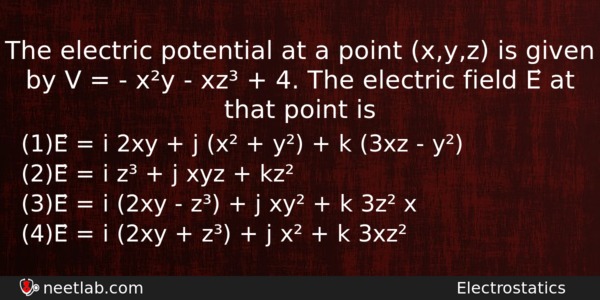| ⇦ | 
| ⇨ |
The electric potential at a point (x,y,z) is given by V = – x²y – xz³ + 4. The electric field E⃗ at that point is
Options
(a) E⃗ = i 2xy + j (x² + y²) + k (3xz – y²)
(b) E⃗ = i z³ + j xyz + kz²
(c) E⃗ = i (2xy – z³) + j xy² + k 3z² x
(d) E⃗ = i (2xy + z³) + j x² + k 3xz²
Correct Answer:
E⃗ = i (2xy + z³) + j x² + k 3xz²
Explanation:
The electric field at a point is equal to negative of potential gradient at that point.
E⃗ = – ?V/ ?r = [ -?V/ ?x i – ?V/ ?y j – ?V/ ?z k ]
E⃗ = i (2xy + z³) + j x² + k 3xz²
Related Questions: - One mole of an ideal diatomic gas undergoes a transition from A to B along a path
- Two capacitors having capacitances C₁ and C₂ are charged with 120V and 200V batteries
- A plane polarised light is incident normally on a tourmaline plate. Its E vector make
- The temperature of ideal gas is reduced from 927° C to 27° C. The r.m.s velocity
- Ratio of longest wavelengths corresponding to Lyman and Balmer series in hydrogen
Topics: Electrostatics
(146)
Subject: Physics
(2479)
Important MCQs Based on Medical Entrance Examinations To Improve Your NEET Score
- One mole of an ideal diatomic gas undergoes a transition from A to B along a path
- Two capacitors having capacitances C₁ and C₂ are charged with 120V and 200V batteries
- A plane polarised light is incident normally on a tourmaline plate. Its E vector make
- The temperature of ideal gas is reduced from 927° C to 27° C. The r.m.s velocity
- Ratio of longest wavelengths corresponding to Lyman and Balmer series in hydrogen
Topics: Electrostatics (146)
Subject: Physics (2479)
Important MCQs Based on Medical Entrance Examinations To Improve Your NEET Score
18000+ students are using NEETLab to improve their score. What about you?
Solve Previous Year MCQs, Mock Tests, Topicwise Practice Tests, Identify Weak Topics, Formula Flash cards and much more is available in NEETLab Android App to improve your NEET score.
Share this page with your friends

Leave a Reply